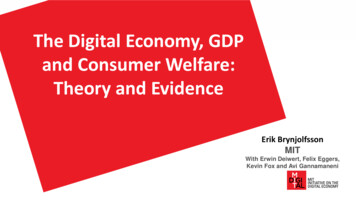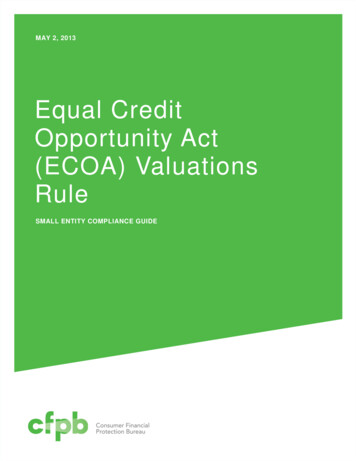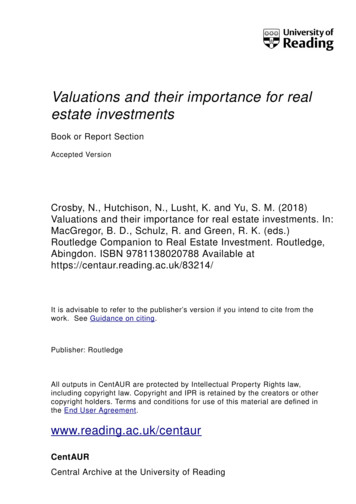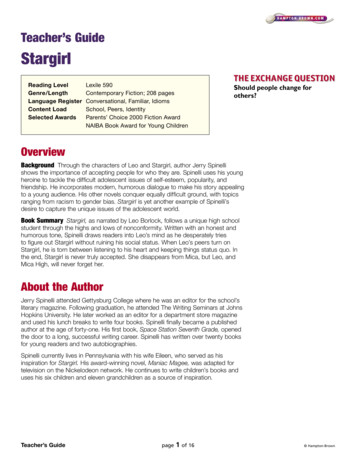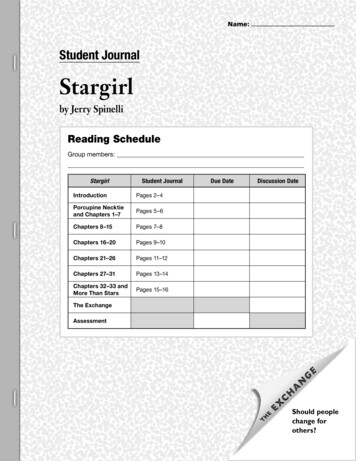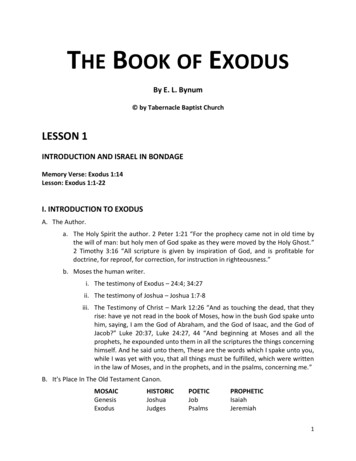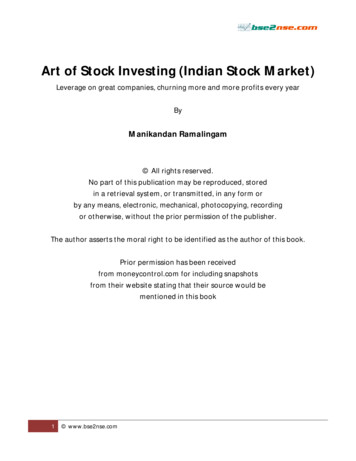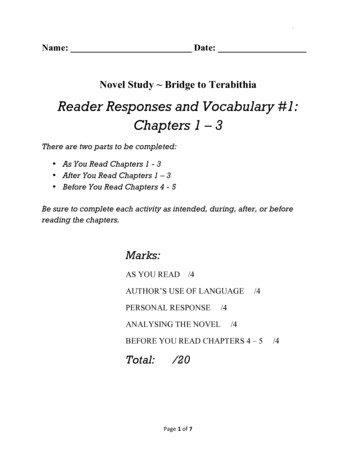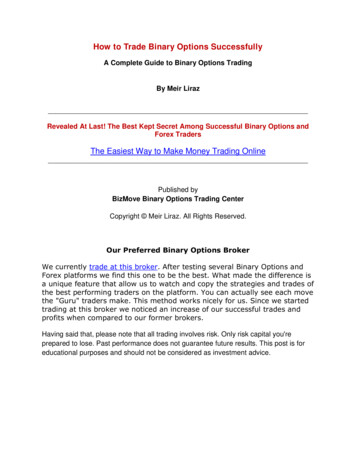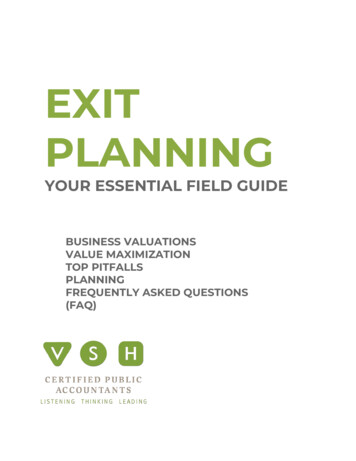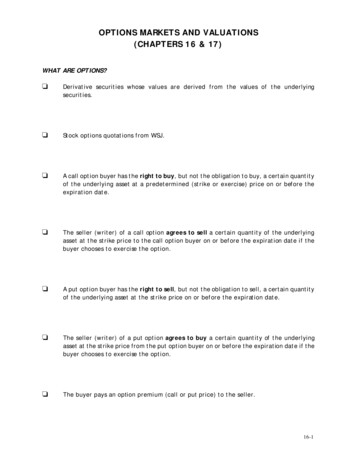
Transcription
OPTIONS MARKETS AND VALUATIONS(CHAPTERS 16 & 17)WHAT ARE OPTIONS?‘Derivative securities whose values are derived from the values of the underlyingsecurities.‘Stock options quotations from WSJ.‘A call option buyer has the right to buy, but not the obligation to buy, a certain quantityof the underlying asset at a predetermined (strike or exercise) price on or before theexpiration date.‘The seller (writer) of a call option agrees to sell a certain quantity of the underlyingasset at the strike price to the call option buyer on or before the expiration date if thebuyer chooses to exercise the option.‘A put option buyer has the right to sell, but not the obligation to sell, a certain quantityof the underlying asset at the strike price on or before the expiration date.‘The seller (writer) of a put option agrees to buy a certain quantity of the underlyingasset at the strike price from the put option buyer on or before the expiration date if thebuyer chooses to exercise the option.‘The buyer pays an option premium (call or put price) to the seller.16-1
BASIC FEATURES OF AN OPTION CONTRACT1.Identity of the underlying security‘Individual common stock; stock and bond market indexes; foreign currencies;futures contracts; Treasury bills and bonds2.Strike or exercise price3.Expiration or maturity date4.5.6.‘Short-term: stock options usually expire in less than 9 months‘LEAPS (Long-Term Equity Anticipation Shares) are options on certain stocks andstock indexes that have expirations of up to three years‘The actual expiration day of a stock and index option is the third Friday of themonthContract size‘One stock option contract represents rights to 100 shares of the underlying stock‘Options on indexes are specified as a multiple, usually 100; e.g., OEX (S&P 100)Exercise style‘European options can be exercised only on the exercise date; most index options‘American options can be exercised at any time on or before the exercise date;most individual stock optionsDelivery or settlement procedure16-2
OPTION TRADING‘Option exchanges: CBOE; New York; American; Philadelphia; Pacific‘Option Clearing Corporation‘Stock Orders vs. Options Orders Stock orders Buy! sell Sell short! buy to coverOptions order Buy Open (call or put)Then three possible actions:1. Sell Close (offset order)2. Exercise the option3. Let the option expire Sell Open (Call or Put)Then three possible outcomes:1. Buy Close (offset order)2. The buyer exercises the option3. Nothing (the buyer chooses to let the option expire)16-3
‘At-the-Money option: when strike price current stock price‘In-the-Money‘‘‘ Call option: when strike price current stock price Put option: when strike price current stock priceOut-of-the-Money Call option: when strike price current stock price Put option: when strike price current stock priceOption Price (Premium): The price the buyer of an option (call or put) pays the seller of the option Intrinsic value for in the money call S0 - X Intrinsic value for in the money put X - S0 Premium (price) intrinsic value speculative premiumEarly Exercise of Options16-4
BASIC OPTIONS STRATEGIES‘‘‘‘Buying stocks vs. buying call optionsSelling (writing) naked (or uncovered) call optionsShort selling stocks vs. buying put optionsSelling put optionsADVANCED OPTIONS STRATEGIES‘‘Covered calls (buy stock and sell call)Protective puts (buy stock and buy put)BUYING STOCKS VS. BUYING CALL OPTIONS‘Buy Stock Pay 20 per share Profit/loss tableST 0 10 30 40Profit/Loss In dollars-20-101020-100%-50%50%100%Profit/Loss In %º Unlimited potential profit but limited potential lossProfit/loss diagram16-5
‘Buy Call Strike price, X 20; current stock price, S0 20 Pay call premium 2 or 200 per contract ST stock price at expiration Call value at expiration (ST - X) if (ST X) 0if (ST # X)Profit/loss tableSTCall ValueCall PremiumProfit/LossReturn (%) 00-2-2-100% 100-2-2-100% 200-2-2-100% 3010-28400% 4020-218900%ºUnlimited potential profit but limited potential loss (the call premium)ºBuying a call option provides a much greater leverage than buying thestock itself and also a limited dollar riskProfit/loss diagram16-6
SELL NAKED OR UNCOVERED CALL Sell call option and receive call premium 2 or 200 per contract The seller does not own the underlying stock Strike price, X 20; current stock price, S0 20 Call value at expiration -(ST - X) if (ST X) if (ST # X)Profit/loss tableº 0STCall ValueCall PremiumProfit/Loss 0022 10022 20022 30-102-8 40-202-18Limited potential profit (the call premium) but unlimited potential lossProfit/loss diagram16-7
SHORT SELLING STOCKS VS. BUYING PUT OPTIONS‘Short Sell Stock Short sell at 20 per share Profit/loss tableST 0 10 30 40Profit/Loss In dollars2010-10-20100%50%-50%-100%Profit/Loss In %º Limited potential profit but unlimited potential lossProfit/loss diagram16-8
‘Buy Put Strike price, X 20; current stock price, S0 20 Pay put premium 1 or 100 per contract The buyer does not own the underlying stock Put value at expiration 0if (ST X) (X - ST ) if (ST X) Profit/loss tableº STPut ValuePut PremiumProfit/Loss 020-119 1010-19 200-1-1 300-1-1 400-1-1Limited, but large, potential profit and limited loss (the put premium)Profit/loss diagram16-9
SELL PUT Strike price, X 20; current stock price, S0 20 Receive put premium 1 or 100 per contract Put value at expiration 0if (ST X) -(X - ST ) if (ST X) Profit/loss tableº STPut ValuePut PremiumProfit/Loss 0-201-19 10-101-9 20011 30011 40011Limited potential profit and limited, but large potential lossProfit/loss diagram16-10
COVERED CALL The call option seller (or writer) owns the underlying stock Strike price, X 40; current stock price, S0 38 Receive call premium 4 or 400 per contract Profit/loss table ST) Stock ValueCall ValueCall PremiumProfit/Loss 0-3804-34 10-2804-24 380044 5012-1046 6022-2046ºThe call premium acts like a cushion or hedge when stock price dropsºLimited potential profit and limited, but large, potential lossºRisk reducing strategyProfit/loss diagram16-11
PROTECTIVE PUT The buyer of the put options owns the underlying stock, similar to buying insurance orforming a hedge against a decline in stock price Strike price, X 20; current stock price, S0 22 Pay put premium 2 or 200 per contract Profit/loss table ST) Stock ValuePut ValuePut PremiumProfit/ Loss 0-2220-2-4 10-1210-2-4 20-20-2-4 40180-216 50280-226ºUnlimited potential profit but limited lossºThe loss the put premium or insurance premium when X S0Profit/loss diagram16-12
VALUATION OF CALL AND PUT OPTIONS‘Determinants of Option Values (Chapter 17, P. 542)Call OptionPut OptionCurrent Stock Price -Exercise Price- Time to Expiration Stock Volatility Interest Rate -16-13
‘The Put-Call Parity (equation 17.2) Portfolio A: Buy a call option and sell a put option on the same stock with thesame exercise price and expiration date The cost of investing in Portfolio A C - P The payoffPayoff at ExpirationPositionST XST XBuy call0ST - XSell put-(X - ST )0ST - XST - XTotal Portfolio B: Buy the stock (paying S0 ) and borrowing a loan with a value thepresent value of the exercise price or X/(1 rF )T The cost of investing in Portfolio B S0 - X/(1 rF )T The payoffPayoff at ExpirationPositionST XST XBuy stockSTSTBorrow loan-X-XTotalST - XST - X Both portfolios have the same payoffs º both must have the same costs C - P S0 - X/(1 rF )T Arbitrage opportunity exists if the parity is violated16-14
‘Arbitrage Example Example 17.2S0 110StockCall option (X 105, 6-month expiration)C 17Put option (X 105, 6-month expiration)P 5Risk free interest raterF 10.25% Portfolio A: C - P 12 Portfolio B: S0 - X/(1 rF )T 110 - 105/(1.1025)0.5 110 - 100 10 Portfolio A is overvalued and/or Portfolio B is undervalued Arbitrage strategy: Sell Portfolio A and buy Portfolio B Payoff tablePayoff at expirationImmediate Cash FlowST 0ST 200Sell call (X 105) 17 0- 95Buy put (X 105)- 5 105 0Buy stock- 110 0 200Borrow loan 100- 105- 105 2 0 0PositionTotalHOMEWORK: CHAPTER 16: 1, 2, 3, 4, 5(no diagram), 20(A&B) and CK 1CHAPTER 17: 2(A-D)16-15
SOLUTIONS: CHAPTER 161.Answer c is false (why)2.Answer c (why)3. 7254.OptionSTPremiumOption ValueProfit/LossACall X 75808.1255-3.125BPut X 758030-3CCall X 80805.1250-5.125DPut X 80804.750-4.75ECall X 85803.3750-3.375FPut X 85807.755-2.755.Investment Value:Stock price 80 100 110 10,36011,360-20%0%10%20%All options (10 contracts)-100%-100%0%100%Bills options-6.4%-6.4%3.6%13.6%All stocks (100 shares)All options (10 contracts)Bills optionsRate of returns:All stocks (100 shares)16-16
20.(A)(B)Sally does better when the stock price is high, but worse when the stock price is low.SOLUTIONS: CHAPTER 172.(A)Put A(B)Put B(C)Call B(D)Call B16-17
16-1 OPTIONS MARKETS AND VALUATIONS (CHAPTERS 16 & 17) WHAT ARE OPTIONS? ' Derivative securities whose values are derived from the values of the underlying securities. ' Stock options quotations from WSJ. ' A call option buyer has the right to buy, but not the obligation to buy, a certain quantity of the underlying asset at a predetermined (strike or exercise) price on or before the
